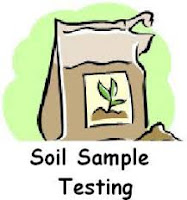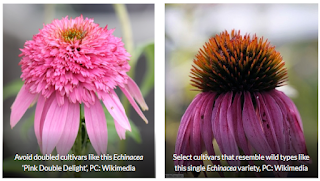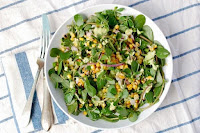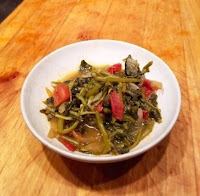 The first time I planned garlic was in the spring of 2018
and thought I had to harvest in the fall.
However, when fall arrived, and I pulled up my first garlic plant, there
was nothing there. Let me tell you about three major mistakes in planting
garlic the first time.
The first time I planned garlic was in the spring of 2018
and thought I had to harvest in the fall.
However, when fall arrived, and I pulled up my first garlic plant, there
was nothing there. Let me tell you about three major mistakes in planting
garlic the first time.
1. Planted in the spring
2. Pulled the plant out of the
ground
3. Didn’t read any
instructions on planting and harvesting garlic
Garlic (Allium sativum) is a member of the onion
(Amaryllidaceae) family and is classified in the same genus to which onion,
leek, chive and shallot belongs. Evidence exists that garlic originated from
Allium longiscuspis, since it does not appear in the wild as a species itself.
The mutation that resulted in garlic probably occurred somewhere in central
Asia. Most scholars agree that garlic has been used as a medicinal plant and
food source for over 7000 years. The latter makes garlic one of the most ancient
of vegetables. According to Bilijana Petrovska,
“for nearly as long as there has been a written record of history, garlic has
been mentioned as a food.”.
 Garlic may
generally be divided into two subspecies: ophioscorodon (hardneck or topset
garlic) and sativum (softneck or artichoke garlic). Hardneck garlic produces
elongated flower stalks (technically called scapes) and bulbils at the top of
the stalk. Softneck garlic does not produce bulbils, except in times of stress.
Garlic may
generally be divided into two subspecies: ophioscorodon (hardneck or topset
garlic) and sativum (softneck or artichoke garlic). Hardneck garlic produces
elongated flower stalks (technically called scapes) and bulbils at the top of
the stalk. Softneck garlic does not produce bulbils, except in times of stress.
Hardneck
garlic may be purple, purple striped, or white and is represented by varieties such as Roja, German Red, Valencia, Continental, and Creole. Creole garlic, a
late variety covered with a deep purple skin.
Softneck
garlic is also referred to as Silverskin, artichoke, or Italian garlic.
Softneck types are best represented by the varieties California Early and
California Late. Silverskin garlic may also be differentiated into many-cloved
or few-cloved varieties, and may also be tan, all white, or purple tinged.
Elephant
garlic (Allium ampeloprasum) is not true
garlic but a type of leek that produces very large cloves (often only 3 or 4
per bulb). Several small bulblets may also develop. Its flavor is milder than
garlic and can be slightly bitter.
Garlic can
be planted late in the fall, after other tasks are finished. The cloves will
produce roots and minimal shoot growth before going dormant late in the season.
Growth resumes in the spring and the bulbs develop, called bulbing, in
mid-summer. Fall planted garlic plants are more mature and will form a larger
bulb while spring plantings of cloves will result in smaller heads of garlic.
Ideally,
the first garlic leaves should emerge above the ground prior to freezing
temperatures in the fall. Planting too early can result in more above-ground
growth that will be vulnerable to winter damage. Do not plant store-bought
garlic from the grocery store produce aisle. It may have been treated to
prevent sprouting—good for shelf life, but bad for planting. Select the
healthiest bulbs for replanting. Since garlic is propagated asexually (without
flower or seed) selecting propagation stock with ideal characteristics will
maintain those characteristics from year to year.
Garlic are
generally pest-free, or the pests found are well-tolerated by the plant. Scout
or observe the garlic planting regularly for any plant injury and make control
decisions based on the pests found in the planting. Some of the more common
pest problems include:
Insect Management
Thrips are insects that suck juices from the leaves,
causing damage. Thrips injury will cause the garlic leaves to turn a silver
color with patchy, dry spots. Typically, this damage will not reduce the
quality of the garlic bulbs.
Bulb maggot is a fly larva that feeds on the developing
bulbs. It is rarely a significant pest of garlic. Soils high in organic matter
can encourage maggots. Crop rotation will help control bulb maggot.
Disease Management
Bloat nematode can be a major problem if introduced to
the garlic planting. These microscopic worms feed inside the heads causing
swollen or misshapen heads and cloves. Once nematodes get into the soil, they
cannot be controlled without significant treatment.
Bulb rot will be a problem in wet years or in poorly
drained soil.
When the
lower leaves begin to yellow, the garlic is ready for harvest. The leaves are connected
to the garlic bulb wrappers below. Waiting until leaves turn brown will result
in rotted or missing wrappers. Also, as the bulbs mature, they may dry and
split, leading to shorter storage life or bulb rot.
Garlic
should be cured or dried prior to storing it for later use. Start by brushing
off any soil remnants clinging to the bulbs. Do not wash them off or get the
bulbs wet. Leave the stalks and roots on the bulbs while they dry.
Allow the
bulbs to cure for 3 to 4 weeks in either a well-ventilated room or a dry, shady
spot outside. Sunlight can change the flavor of fresh garlic.
Once the
tops and roots have dried, you can cut them off, if desired, or leave them on
and braid the garlic into bundles of four to six plants. You can also further
clean the bulbs by removing the outer skins. Just be careful not to expose any
of the cloves.
For more
information check out these sites:
 Our winter sunshine is a plus in this, as you can get outside even in January and February to mess with lumber, edging or stepping stones (unless the snow hits).
Our winter sunshine is a plus in this, as you can get outside even in January and February to mess with lumber, edging or stepping stones (unless the snow hits). 





































